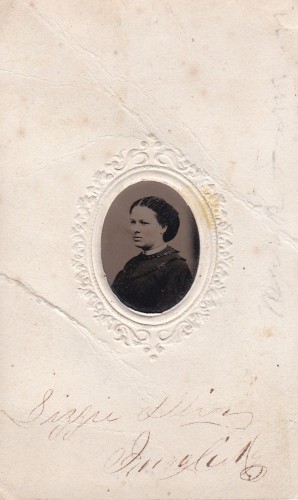Tuesday’s Tip: Compare Photos Carefully and in Context- The Frances “Fannie” Isabella (Brown) Chapman Photo Collection
Beerbower Family (Click for Family Tree)
Any family historian lucky enough to find a batch of photos is likely to find some in that batch that are not labeled, or have incomplete labels. Sometimes a photo might include just a first name, or a place, or a date- frustratingly often just one of these, or just nothing. After all, the original owner knew who all the people were, so why put names on them??
Tuesday’s Tip: Study each photo individually to glean as much information as possible, but also look at the photo in context with others found with it, and others you may have.
These photos were in the Fannie Belle Brown Chapman Collection. The family believes these were friends and/or schoolmates of Fannie and her sister Ida, and hope that they can find descendants and give them the images. (Contact us if you are related!)
So how does one sort out who is who?
- Keep collections or boxes, envelopes, scrapbooks, etc. of photos together; include the negatives if you have them.
- Making a scan or taking a picture of them all laid out in the order you received them might be helpful.
- If you are scanning a scrapbook, scan each page and number accordingly, then scan individual photos at a higher resolution. This will help keep the images in context.
- Label your scans appropriately. Include the name of the collection, side of the family, type of image, and anything you can add to help ID the photo. An example of a file name for the above picture might be:Year_four digit month/day_SPEERY_Lizzie_fm Fannie Belle Brown Chapman Collection_tintypeThis will ‘automagically’ sort your images by date and person; I use individual family folders and when people become adults, they get a new folder with the two names:CHAPMAN_Unknown- BROWN_Fannie BelleI usually put the husband’s name first, as adult records are generally under that name for both of them.
- Now that you have familiarized yourself with the collection as you scanned the images, and have a record of their context, look at each image carefully. Look at them in a variety of lights, and tilt them in the light to see if you can find any markings on them- both pencil and ink fade over time, but sometimes the ‘graphite’ of a pencil will glisten if angled just right in the light, or there may be an impression where the writer pressed hard. Enlarge your digital images- sometimes the camera will pick up something your eye did not.
- Write down everything you know about the image, using metadata, and a text file that has the same name as the photo but ends in ‘.txt.’ (TextWrangler is a good text app for Macs.)
- Look for clues in the photos. For example, the above photo was labeled as, “Lizzie Speery.” Looking at other photos, there was another, older Lizzie in the group:
It is hard to read the writing, but this photo definitely says, “Lizzie”- maybe ‘Hines’? Then it looks like the name of a city, and possibly ‘NY” after.
Think about the context- two Lizzies, the only person to have 2 photos in the collection. Different last names, but the first image was a young girl, the second a mature woman, and the different last name is likely a married name.
Could these Lizzies be the same person with some years in between photos? Take a look at her eyes, chin, nose- what do you think? (Let us know in the comments.)
- Try to date the photos by dress, type of image, etc. Maureen Taylor, “The Photo Detective,” has excellent books, webinars, classes, speaks at genealogy conferences, and will even do video/phone consults; there are other resources as well to help determine approximate time periods. In the case of our two Lizzies, dating each photo might help us determine if they could possibly be the same person. Lizzie might have been a childhood friend or a distant cousin, possibly who moved away, but then the women exchanged photos in later years?
- If there is information available about a photo studio on the back of the image, use Google to try to learn when and where the photographer was in business to give you clues. They often changed the backs of photos as they added a partner or one moved on, or just to update their look or logo. Sometimes images on eBay can even help one determine the years a photo studio was in business, giving you another clue to time period.
- Crowd-source your detective hunt by posting your unknown photos on a blog, a website such as DeadFred, Facebook, etc.And, as always, keep copies of your photos and the description file on your own computer or media- online services may not be here forever, some use proprietary software that will not be readable in the future, etc. (Text (.txt) files should be readable for a long time.) This is redundant but redundancy is a good backup. Keep copies of all these images somewhere other than your computer- a drive you keep in a safe deposit box, give to a sibling, etc. The cloud is a good option too, but not failsafe, so always have your own copies.
Notes, Sources, and References:
- Fannie Belle Brown Chapman Collection, with permission.
- Lizzie Speery apparently worked as or with a photographer.
Please contact us if you would like higher resolution images. Click to enlarge images.
We would love to read your thoughts and comments about this post (see form below), and thank you for your time! All comments are moderated, however, due to the high intelligence and persistence of spammers/hackers who really should be putting their smarts to use for the public good instead of spamming our little blog.
